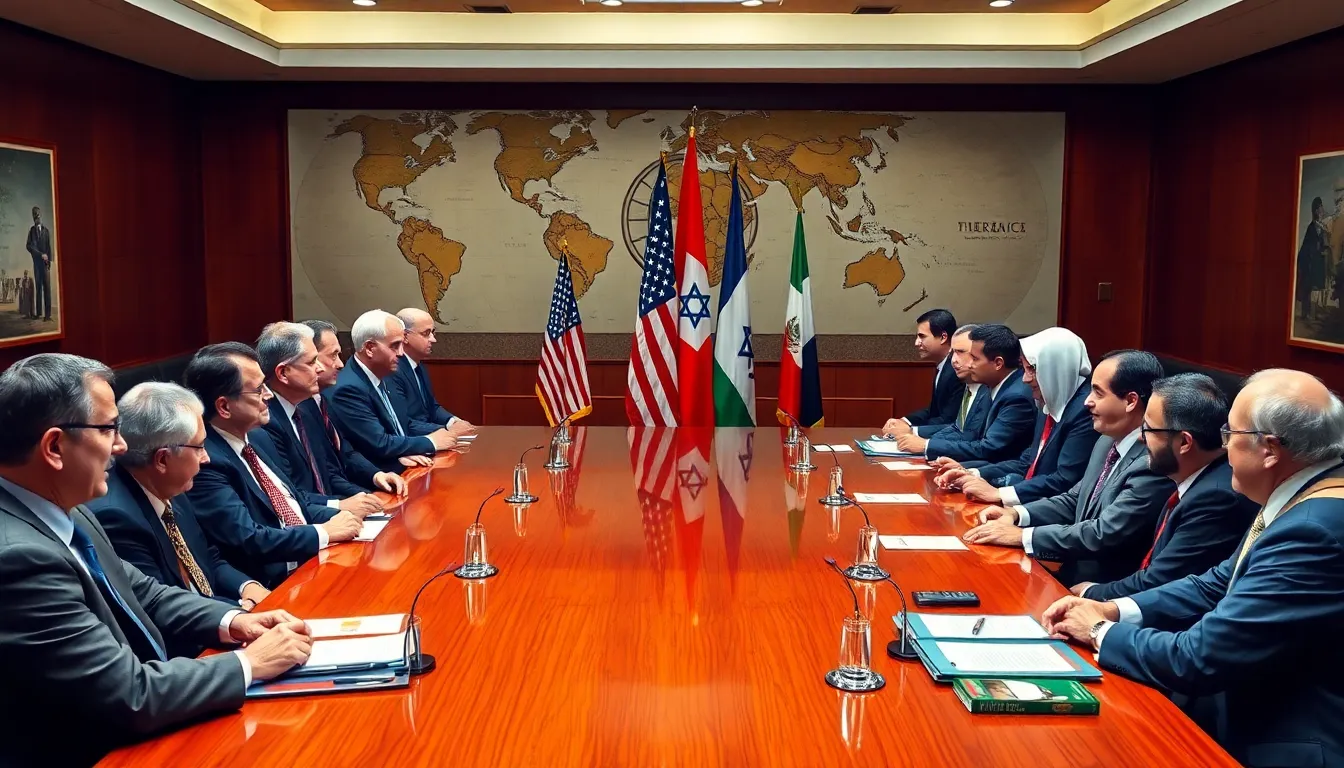The Abraham Accords burst onto the scene like a surprise party no one asked for, promising peace and prosperity in the Middle East. But instead of a joyous celebration, it seems the balloons popped and the cake went stale. What went wrong? Was it a case of too many cooks in the kitchen or simply a recipe for disaster?
As nations celebrated their newfound friendships, underlying tensions simmered like a pot of overcooked pasta. The lofty goals of the Accords quickly collided with harsh realities, leaving many wondering if they were just a diplomatic mirage. Dive into the complexities of this ambitious agreement and discover the reasons behind its unraveling, sprinkled with a dash of humor and a whole lot of insight.
Table of Contents
ToggleOverview of the Abraham Accords
The Abraham Accords represent a significant diplomatic initiative aimed at normalizing relations between Israel and several Arab nations, including the United Arab Emirates and Bahrain. The agreements, signed in September 2020, marked the first major breakthrough in Arab-Israeli relations in decades. They promised economic cooperation, cultural exchange, and enhanced security collaboration.
Signatories viewed the Accords as a pathway to a more stable and prosperous Middle East. Both Israel and the participating Arab nations expressed hope for improved trade, tourism, and technological advancements. Additionally, many believed these Accords could lead to a larger reconciliation process involving other Arab states.
Despite these optimistic aspirations, challenges arose almost immediately. Internal divisions within the Arab world complicated the implementation of the Accords. Public opinion often remained skeptical, particularly in Palestinian territories, where leaders felt sidelined in the peace process.
Every major player in the region faced pressure to balance their political ambitions with public sentiment. Compounding these issues, regional tensions related to Iran’s influence persisted, affecting the stability the Accords sought to build. Furthermore, the change in U.S. policies and leadership after 2020 added another layer of uncertainty to the agreements’ effectiveness.
Some analysts argue that the Accords were overly ambitious, lacking broader support for sustainable peace. Others question whether the framework accounted for the complex historical grievances present in the region. Faith in the process has waned, leading many to wonder if these Accords can achieve their intended goals.
Key Players Involved

Several key players influenced the dynamics surrounding the Abraham Accords. Understanding their roles highlights the complexities of the initiative.
United States
The United States was a primary facilitator of the Abraham Accords. It played a central role in negotiating terms and providing diplomatic support. Under the Trump administration, a strong push for normalization occurred, prioritizing regional stability over longstanding conflicts. However, shifts in U.S. policy following the 2020 elections created uncertainties. The Biden administration’s approach has focused more on traditional conflict resolution, impacting the original momentum achieved by the Accords.
Israel
Israel emerged as a significant beneficiary of the Accords. Normalization with Arab countries promised enhanced security and economic ties. Leaders in Israel viewed the agreements as opportunities to counter threats from Iran. However, reaction to the Accords among domestic groups varied. Public opinion in Israel remained polarized, with some citizens questioning the long-term implications for peace with Palestinians.
Arab Nations
Arab nations involved, notably the United Arab Emirates and Bahrain, sought economic benefits through the Accords. They prioritized technology transfer and trade enhancements. Internal politics in these countries complicated their commitment to the agreements. Leaders faced pressure from constituents skeptical of aligning with Israel. Ongoing Palestinian struggles also resonated deeply, impacting public sentiment across the Arab world.
Major Challenges Faced
Multiple obstacles hindered the success of the Abraham Accords. Political and economic factors continually influenced the effectiveness of this landmark agreement.
Political Divisions
Political divisions within the Arab world severely impacted the Accords. Countries like Saudi Arabia displayed reluctance to engage in normalization, fearing backlash from both citizens and regional partners. Palestinians voiced strong opposition, viewing the agreements as a betrayal of their aspirations. Internal political dynamics in each nation further complicated consensus-building. Leaders encountered pressure not only from rival factions but also from their populations, who often hold differing views on relations with Israel. Arab governments grappled with the need to balance their interests with public sentiment.
Economic Disparities
Economic disparities also factored into the challenges of the Accords. While nations like the UAE capitalized on opportunities for trade and tourism, other Arab countries lagged behind. The differing economic conditions created an uneven playing field, leading to skepticism about shared benefits. Inequalities highlighted disparities in resources and the ability to engage with Israel on economic fronts. Countries with weaker economies expressed concerns about being left out of potential partnerships. Addressing these economic imbalances remains crucial for the long-term viability of normalization efforts across the region.
Lack of Commitment
Lack of commitment undermined the Abraham Accords’ intentions, preventing sustained cooperation among participants.
Failure to Implement Agreements
Implementation of various agreements proved challenging. Israel, the UAE, and Bahrain struggled to translate lofty promises into actionable policies. Economic ventures and security collaborations lagged due to insufficient follow-through from the signatory nations. For instance, only a small percentage of proposed joint initiatives materialized, causing frustration among stakeholders. Negotiations often stalled, as differing national priorities hindered collective action. Enthusiasm quickly waned when countries prioritized their domestic issues over the agreements.
Regional Tensions
Regional tensions significantly impacted the Accords’ effectiveness. Conflicts between Iran and its allies created an environment of distrust among countries. Strong opposition from Palestinian factions further complicated matters, as these groups viewed normalization efforts as a betrayal. Arab nations faced pressure to align with public sentiments against perceived injustices. Relations with other regional players, such as Turkey and Qatar, also created friction, leading countries to reevaluate their commitments. Ongoing hostilities in Gaza and elsewhere exacerbated the situation, perpetuating an atmosphere of uncertainty and fear.
The Abraham Accords represent a pivotal moment in Middle Eastern diplomacy but ultimately fell short of their ambitious goals. Internal divisions among Arab nations and strong public skepticism have hindered meaningful progress. Political pressures and the ongoing Israeli-Palestinian conflict have further complicated efforts to solidify relationships.
As the region grapples with changing U.S. policies and the influence of Iran, the path forward remains fraught with challenges. The Accords’ initial promise of economic cooperation and stability has yet to materialize fully, leaving many questioning their long-term viability. The future of these agreements hinges on a renewed commitment to dialogue and understanding among all parties involved.









